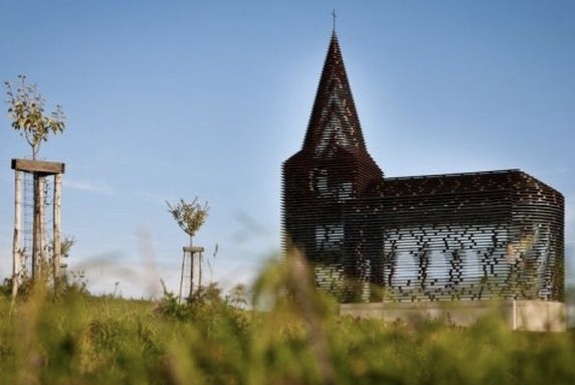The Pacific Northwest is one of the most fertile seedbeds for religious innovation and creativity in North America. To be sure, the separation of church and state has historically made North America as a whole an exceptionally open religious environment. That said, the Pacific Northwest (PNW) seems to exceed all other regions in its receptivity to religious experimentation.
What makes the PNW so uniquely “open” to creative new expressions of religion and spirituality? There are many contributing factors but one of the most important has to be the utter lack of a single religious majority. The largest religious institution in Cascadia is the Roman Catholic Church, which claims between 10-15% of the population. Such numbers are nowhere near those necessary for cultural dominance.
As Patricia Killen points out in her research on the region, when one religion is dominant, individuals face significant social pressure to conform to a common sense of what is “normal.” More importantly, in the shadow of a dominant religion, the creativity of new and minority religious groups is stifled by the need to clarify how the group is “like” the dominant religion and “unlike” it. In all of its history the PNW has never had such a singular and unified religious presence. Because of this lack of a religious center, the region has been unusually open to new and creative forms of religious life. One need only consider the non-traditional religious communities that have sprouted throughout the region such as Portland’s now defunct Living Enrichment Center and Everett’s Wiccan Aquarian Tabernacle Church.
The “openness” of this religious marketplace has made the Northwest a fascinating laboratory for church planting studies. As a Seattle native and former pastor in the city, I am currently conducting dissertation research on recent Seattle church plants. Through this research I am eager to highlight examples of ecclesial creativity and faithfulness in church identity, spirituality, and mission.
While the research is still in its early stages, I have already confirmed the existence of 90 churches planted within the Seattle city limits since 2001. An additional 25 churches are also likely to be confirmed and another 14 (at least) are currently forming.
Of course, Seattle is not the only place church planting is happening. Ed Stetzer and Dave Travis suggest that roughly 4000 new churches are being started annually in the U.S. This number represents a dramatic rise from the early decades of the century. Warren Bird claims that, as a result, church starts have outpaced much-lamented church closures.
The unique openness of the PNW does not necessarily mean that more churches are being planted in this region than elsewhere. Still, with the nation as a whole following the Northwest trends of declining confidence in organized religion and increasing numbers of “Nones,” the Northwest offers a glimpse of the future of church planting in the U.S. Below, I offer a brief portrait of some of the latest churches that have taken root in Seattle’s uniquely open and fertile soil.
Planting Players
Who is starting new churches in Seattle? Not surprisingly, the strong majority roughly 4 out of 5 of the new churches have been started by Evangelicals and Pentecostals with missionary zeal and a knack for cultural adaptation. This is not to say that new churches are predominantly non-denominational; indeed less than 25% are. What Leadership Network’s research found nationally holds true in Seattle; the great majority of church plants are linked to a denomination in some way. The largest number of denominational affiliated churches are the result of efforts by Seattle Church Planting, an organization tied to the Southern Baptist Convention, who is responsible for nine church starts and has five more prepping to launch. The Assemblies of God and Foursquare denominations have also been very active and have each planted eight churches. More surprising, perhaps, are the contributions from mainline denominations: Presbyterian Church USA (7 churches, including ethnic fellowships), United Methodist Church (2), Episcopal Church (1.5), Evangelical Lutheran Church (1.5), and Catholic Church (1).
One of the differences that seem to distinguish the most active denominations in church planting is their involvement in ethnic church planting. Pastor Doug Heck of Horizon Church reports having launched at least one church every year since 1993, and as such has been the catalyst for more than half of the Foursquare gains, including Ethiopian, Eritrean, Liberian, Korean, and Japanese churches. Preliminary estimates indicate roughly 30% of the new Seattle churches are identifiable with a non-white and/or non-English cultural or language group.
Another major producer of new churches in Seattle are large churches that have adopted a multisite strategy. These multisite campuses/churches amount to approximately 10% of new Seattle churches. The most prolific and well-known in this regard is Mars Hill Church, who has not only started four multisites in Seattle since 2001, but has a total of 14 campuses (with two more coming soon) as far away as New Mexico. In addition, two other new Seattle churches are part of the Acts 29 Network born out of Mars Hill Church. Three churches with roots outside of city limits have established two sites each within it, including City Church, Eastlake Community Church, and Calvary. Bethany Community Church has also “gone multisite” adding locations in West Seattle and just north of the city.
Naming New Churches
The names chosen by these church planters provides one window into the creativity and identity of these communities. Seattle multisite churches universally follow the name/ place format as is evident in Eastlake/Magnolia, City Church/ U-District, and Calvary/ The Hill.
Beyond multisite campuses, traditional, neighborhood-based names like Columbia City Church of Hope and Ballard Church are surprisingly rare, even among churches with a strong neighborhood identity. The names of ethnic churches often make clear their cultural identity, with the exception of predominantly African-American churches. A large number of these new churches have adopted names with fairly transparent Christian significance, such as Emmanuel (3 churches), Sanctuary (2), and Restoration (2), while others appeal to an ancient sense of the sacred (Church of the Apostles, All Souls, The Hallows, All Pilgrims, Pilgrimage). Some seem to have chosen names meant to amuse (Wit’s End), puzzle (bE.kON, Lux), intrigue (Skate Church), inspire (Epic Life, Quest), or break negative stereotypes (Church of the Undignified).
Given the significance of geography for Cascadian culture, it is somewhat surprising that only two new church names explicitly evoke environment-related themes (Valley & Mountain and The Garden). This may be explained by the chasm between evangelicals and “spiritual environmentalists” in the region, described by Patricia Killen. This tension not only causes church planting evangelicals to distance themselves from demonized ‘tree-hugging pagans,’ but as Killen notes, it poses a challenge to mainline Protestants and others whose theological identity fits well in neither camp. Indeed, the two churches that have opted for nature-rich names are both from liberal mainline denominations and presumably desire to break out of the dichotomy, though some evangelicals are sure to brand them as accommodating to a pagan culture.
Creative Worship Spaces
The creativity of new Seattle churches is not limited to their names. Their gathering places are also non-traditional, including; church basements, outfitted warehouses, cinemas, theaters, homes, restaurants, schools, and community centers. While some plants have purchased church buildings, limited resources and theological sensibilities have led others to rent worship space. Still others buy or lease property primarily to open it up to the community as a coffee or chocolate shop, community living room, or a space for community organizing and the arts. Some new Seattle churches are making more radical moves away from the congregational model of church—centered on the practice of gathering for worship in a fixed place and time—and are experimenting with innovative forms of Christian community. For example, the central church practice for Community Dinners is hosting free neighborhood feasts where servers and guests alike are considered members of the body. Awake puts a priority on offering safe space and friendship to those affected by house-lessness, prostitution, and addiction, springing from their strong sense of church as parish along Aurora Ave.
In summary, while low participation rates and relatively weak religious institutions typify the region, these very same conditions have created the soil in which numerous innovative new church plants have taken root. These diverse and creative churches are concrete products of the uniquely open religious environment characteristic of the PNW. My continuing research draws on surveys, participant observation, and interviews to explore the dynamics of ecclesial identity, mission and spirituality among this cohort of new churches. From the riches of their creativity, I intend to offer practical and theological insights with relevance for the wider church, as Christendom in the U.S. wanes and the national religious climate bears increasing resemblance to that of the PNW.


